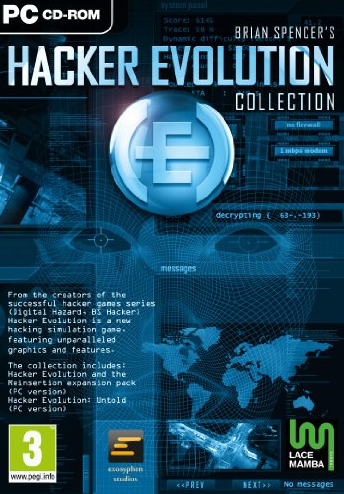
A third, RTS-esque game, Hacker Evolution: Duality was released on 15th August, 2011.
This game series provides examples of the following tropes:
- A.I. Is a Crapshoot: The main plot of both games.
- Disproportionate Retribution: In Hacker Evolution: Untold, John kills Brian's family just because of a bit of hacking!
- Drought Level of Doom: Operation Electrosphere, included with the Steam version of Hacker Evolution, gives a large cash sum of $50000. The following three final levels have no money, and a minimum of one third of the lump sum needs to be spent for removing your trace.
- Dynamic Difficulty: An option enables the dynamic difficulty factor in the game. Although one manual included with the game says it's not clear what it does, it multiplies the bit-length of decryption keys. The dynamic difficulty is calculated based on upgraded hardware, which has a flaw when you upgrade your stock system to have a class 2 firewall (increasing dynamic difficulty), then upgrade by adding a 1 Ghz CPU (reducing dynamic difficulty to default).
- EMP: A satellite hacking tool in Duality, which simply damages a target's firewall and integrity. It has a minigame which requires the satellite to point in the right direction.
- Fighting a Shadow: John Davis in the first game is actually a decoy for Xenti's AI
- Gone Horribly Right: In Hacker Evolution: Untold, Xenti's AI was originally supposed to be an automatic marketing tool. It starts killing people who are resistant to marketing.
- Hacking Minigame: Duality requires clicking on a set of numbers, from 63 down to 0 - but highlights the number if you take some time.
- Hollywood Hacking: The first games have the user type in commands for automated cracking. Duality seems to prefer visual hacking display.
- Instant-Win Condition: Completing all objectives advances you to the next level after a 15 second delay, even if you still have tasks you want to perform (e.g. transfer money from remote servers.) The sequel instead allows you to continue the hacking session for 10 minutes, which is more than enough time to finalize other tasks.
- It's Personal: John in the second game
- Kick the Dog: John in the second game
- Password Slot Machine: While the decoding process is not shown on-screen, it behaves as if characters/bits are decoded one at a time.
- Piecemeal Funds Transfer:
- Money transfers in this game are done in single blocks. However, larger amounts of money take longer to transfer as if the trope was in effect, and therefore puts a limit on how much can be transferred at once.
- In Untold, the car-chase level involves hacking the ATM for money. The tutorial instructs the player to transfer $1000 in consecutive transfers rather than doing it all at once.
- Duality has the money transferred in a normal piecemeal fashion, although the entire amount must be transferred.
- Phone-Trace Race: Computer hacker variant. While attempting to crack passwords, decrypt keys or obtain money, the task needs to be done within a time. You can extend the time using server bounces or getting a firewall. Failing the trace gives a major penalty to the trace meter, although success still causes a slight increase.
- In case of Duality, the trace timer counts down while you have a given server selected rather than just cracking it. However, the trace level only goes up gradually rather than a large penalty at once.
- The Singularity: The plot of the second game.
- Temporal Paradox: The first game involves informational time travel. The player character, Brian, is supporting Xenti's AI from the future, basically fighting himself.
- Timed Mission: Only the first two missions in Duality are explicitly timed (including the tutorial). There are also rival AI hackers that attempt to attack the player, providing a flexible time limit as well.
- Tutorial Failure: The tutorial does a good job at explaining game mechanics, but has to be done more than once: it guides you towards a 50% trace penalty for being detected, which is a serious penalty that gets carried to non-tutorial levels. It can be corrected by spending $2500, but it's better to exploit prior knowledge to optimize the result.
- In case of Duality, the firewall hacking window incorrectly states clicking "logout" prevents being traced. Instead, the player should select localhost or press space. The tutorial message shown beforehand gives the correct instruction.
- Sequence Breaking: Knowing the name of a server allows you to access them out of order.
- Unwinnable by Design: While there's more than enough money available, it's possible to enter a state where you don't have enough money to proceed with the next objective. The developers intended the unwinnable state to remain within just one mission, by requiring a trace level below a given threshold at certain chapters.
